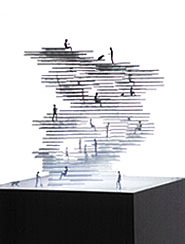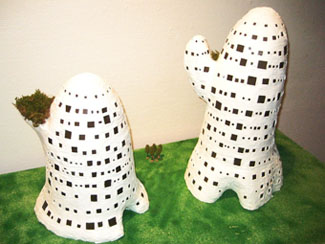 |
|
 |
Sou Fujimoto's theoretical Primitive Future House of stacked slabs is all about gradations, nuance, and contextual reference -- a model the architect hopes to apply to whole urban areas. © Sou Fujimoto Architects
|
|
Terunobu Fujimori encourages his students to stop sketching and start building -- to shape their thoughts into tangible designs. His Tokyo in 2107 envisions a post-apocalyptic city of coral-like, photosynthesizing towers. Photo © Roland Hagenberg |
|
|
|
|
The start of a new decade was not lost on those involved in architecture in Japan as 2009 came to a close. In Tokyo, October's Archi Future 2009 symposium drew 2,800 architects, structural engineers, and product designers in a single day for practical presentations on Building Information Modeling (BIM) and other cutting-edge information technologies, while in Fukuoka, the well-curated Architecture of the Future exhibition pulled in a crowd of 250 on the opening night of its six-week run in December and January.
More contemplative than technical, the Fukuoka show was exciting in scope. Eleven of the country's most innovative architects shared -- via sketches, paintings, models, and photographs -- their view of the design aspects they consider most significant in shaping our future. As if the 70 works by Jun Aoki, Mark Dytham, Terunobu Fujimori, Sou Fujimoto, Hiroshi Hara, Toyo Ito, Astrid Klein, Kengo Kuma, Ryue Nishizawa, Kazuyo Sejima, and Yasuhiro Yamashita that filled the walls and spaces of Mitsubishi-Jisho's Artium gallery were not enough to savor, the exhibition concluded with a provocative 48-minute film presenting these architects' candid answers to seven pointed questions about the future of the field. The whole was an intoxicating, sometimes contradictory, and altogether enjoyable mix of philosophical musings, creative doodlings, incisive assessments, and inspiring applications that gave visitors both insight to the unique character and approach of these influential designers, and pause to reflect on concerns ranging from the local (are tatami mats destined to disappear from Japanese homes?) to the global (how much does, or should, consumerism influence tomorrow's architecture?).
The brainchild of Roland Hagenberg, an Austrian writer, photographer, and filmmaker based in Tokyo, Architecture of the Future was a multimedia extension of themes addressed in his 2009 book, 20 Japanese Architects (a source of some solace for those who missed the show, which closed on January 11). Having collaborated with dozens of architects in Japan over the years, Hagenberg has come to see them occupying two distinct groups -- "one I call the Shell," he explains, "the other the Skin. The former are driven by a need to make heroic concrete monuments. It's a trend that began in the early postwar years and has led to artistic egotism and dictatorship of style. It forces us to lead our lives in uncompromising bunkers and fortresses. The Skin approach to design, however, is like a protective extension of the body -- a coat tailored to our moods and physical needs." Hagenberg believes that this approach -- in which buildings, like a permeable membrane, respond to their environment and the naturally messy flow of life -- is what will come to define tomorrow's built environment. "Skin architecture is transparent and open not only in the physical sense," he continues, "but also in terms of information exchange. It emerged gradually after Japan's bubble economy burst. And the architects featured here have already started to shape that future."
From Fujimoto's sketches and model for the conceptual Primitive Future House to Fujimori's whimsical vision of self-healing towers, Hara's exploration of the possibilities posed by five-meter cubes of space in low-cost housing, and Klein and Dytham's real-life solution for revamping outdated bubble economy structures, Architecture of the Future presented a compelling cross-section of the minds at work in Japan today, creating the ideas and approaches that will inform our built world in the years ahead.
This summer, Hagenberg plans to bring these architects to the small village of Raiding, Austria -- the birthplace of Franz Liszt and the European center for Liszt studies and festivals. Under the auspices of the Raiding Foundation, an organization founded last July to promote cultural exchange between Japan and Austria, the architects will participate in a series of lectures and events and will propose new, ecological works to update the village infrastructure ahead of its bicentennial celebration of Liszt's birth in 2011.
|